Founder and first-generation winemaker of Domaine Giudicelli: “Making wine requires serious commitment”.
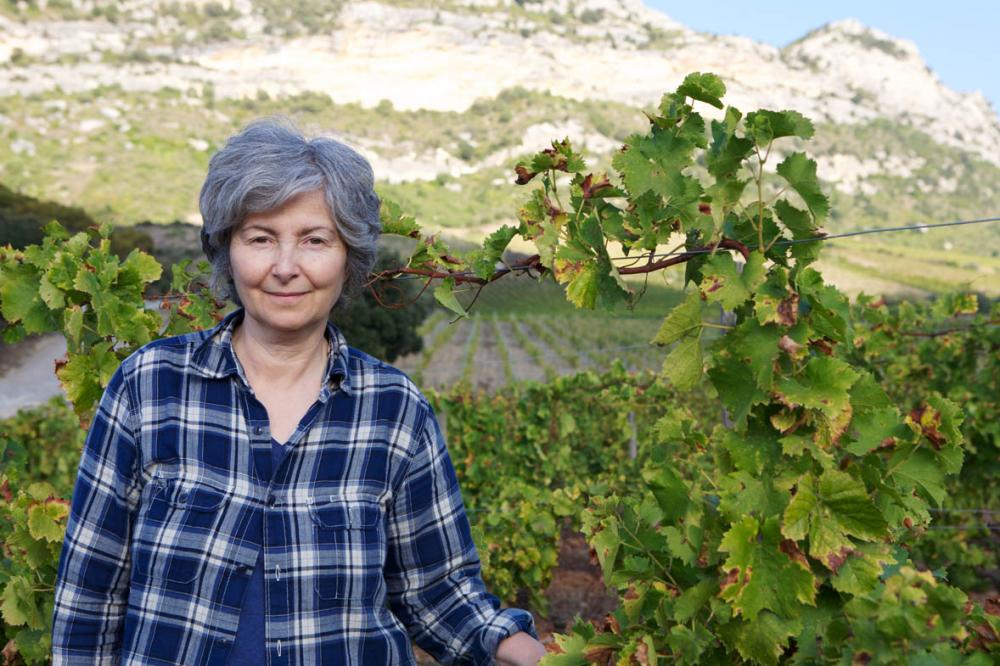
For the fourth in Le Figaro Vin’s series, we cross the water to Patrimonio, in Corsica, where Muriel Giudicelli, #47, creates her exquisite island wines. Here she shares her journey as a self-taught winemaker, on land she cherishes with a deeply-felt love.
Le Figaro: How does it feel to be crowned a winemaking champion?
Muriel Giudicelli: I am very proud for my appellation and for raising the profile of Patrimonio. I am a first-generation winemaker in Corsica, not a Corsican by birth. I want to play my part as an ambassador for this splendid terroir.
Have you been training for long?
From the age of thirteen! I have always been in it for the long haul. Wine was a shared family passion, which gave me an early appreciation of it and spared me the messy pitfalls of adolescent drinking.
Who is your mentor?
My parents, who were engaged in a continual tug of war. My father was on team Bordeaux, my mother team Burgundy. So I was the fortunate beneficiary of a double initiation, even if I have to acknowledge that Burgundy won out.
Is wine a team sport?
Yes, absolutely, as embodied in our estate: my husband takes care of the vines while I take care of the wine. And our team is soon going to get bigger, as our children are joining us. That makes me very happy and it will keep our egos in check.
What is the key to making a good wine? The terroir or the winemaker?
The terroir. A great winemaker can make a decent fist of inferior terroir but never a great wine. On the other hand, on good terroir, even a poor winemaker given a fair wind, who sits back and largely lets nature take its course, has a chance of producing something good.
To what do you owe your success?
I was lucky to love cooking, combining the right ingredients with a good sense of taste, without ever following recipes. I use the same process in my cellar. While my daughter is studying cookery, I don’t think that studying viticulture and oenology is essential, because you are always having to unlearn what you have learnt. In order to make wine you need to know how to taste, think ahead creatively, and, above all, make the best of what you’ve got. It all comes down to balance.
Are your parents proud of you?
Yes, very proud. They are great wine lovers. That said, my father is completely partisan. Even when my first efforts at winemaking were dreadful, he was full of praise. My mother, who taught in primary schools, has a discerning palate and strictly objective standards. As a result, she is far harder to please. When she tells me that a wine is “not bad”, that’s a real compliment.
Your favourite colour?
Red. Because it’s hard to mess up a white wine in Patrimonio.
The king of grape varieties?
Niellucciu (a red grape variety native to Patrimonio, ed.). It has the temperament of a Corsican, so you need to handle it with tact and diplomacy. You must always take pains to understand it. I didn’t understand it when I started, so that drinking my wines was truly like scaling your teeth.
Your favourite wine?
A blend of Niellucciu and Sciaccarellu, which comes out in 2024. Its name will be Terra Ros (Red Earth, ed.) because the vines are rooted in red clay soil.
Your favourite vintage?
2016, for both reds and whites.
If your wine was a person, who would it be?
I hope it is like me.
What are the best circumstances in which to taste your wine?
Among friends around a good meal. The psychological factor plays a big part in tasting, perhaps even more than the wine itself.
Have you ever thought about chemically enhancing yourself, or your wine?
I used additives when I started, not knowing how to vinify. I was all over the place, trying out different concoctions, which is why I want to spare my children from making the same mistakes. It was truly sad, I was hopeless.
For what price would you be prepared to sell your estate?
The question has come up, because there was a long period when my children didn’t want to take it on. But we could never bring ourselves to fix a price, because of our visceral attachment to our land. I cannot put a price on it.
Who is your strongest competition in Corsica?
Rather than a competitor, it is someone who has been much more a mentor. Antoine Arena’s opinion really matters to me and he was the person who helped me get established. I think that, by now, I have earned his approval, which is a big thing, because he has an overall responsibility for the appellation. I would hate to disappoint him. He is something of a spiritual father to me.
What has been your most innovative strategy in the vineyard and in the cellar?
A battle I won with myself. I had some pretty fixed ideas when I started and didn’t believe in temperature regulation. Although I remain convinced that it’s a heresy in the case of white wines, I was forced to use it to deal with a micro fungus which affects the vines we use for my reds. This has required maintaining a temperature of around 25°C. I now realise that this has greatly improved the tannin extraction. It has markedly changed the profile of my reds.
Who would be your ideal successor on the podium?
I hope it will be my children. They have learnt that making wine is not just about having fun; it’s a serious business, which requires serious commitment. It is also a commitment to the appellation.
Chef de caves of one of Champagne’s cult family estates: “Wine bonds us and binds us”.
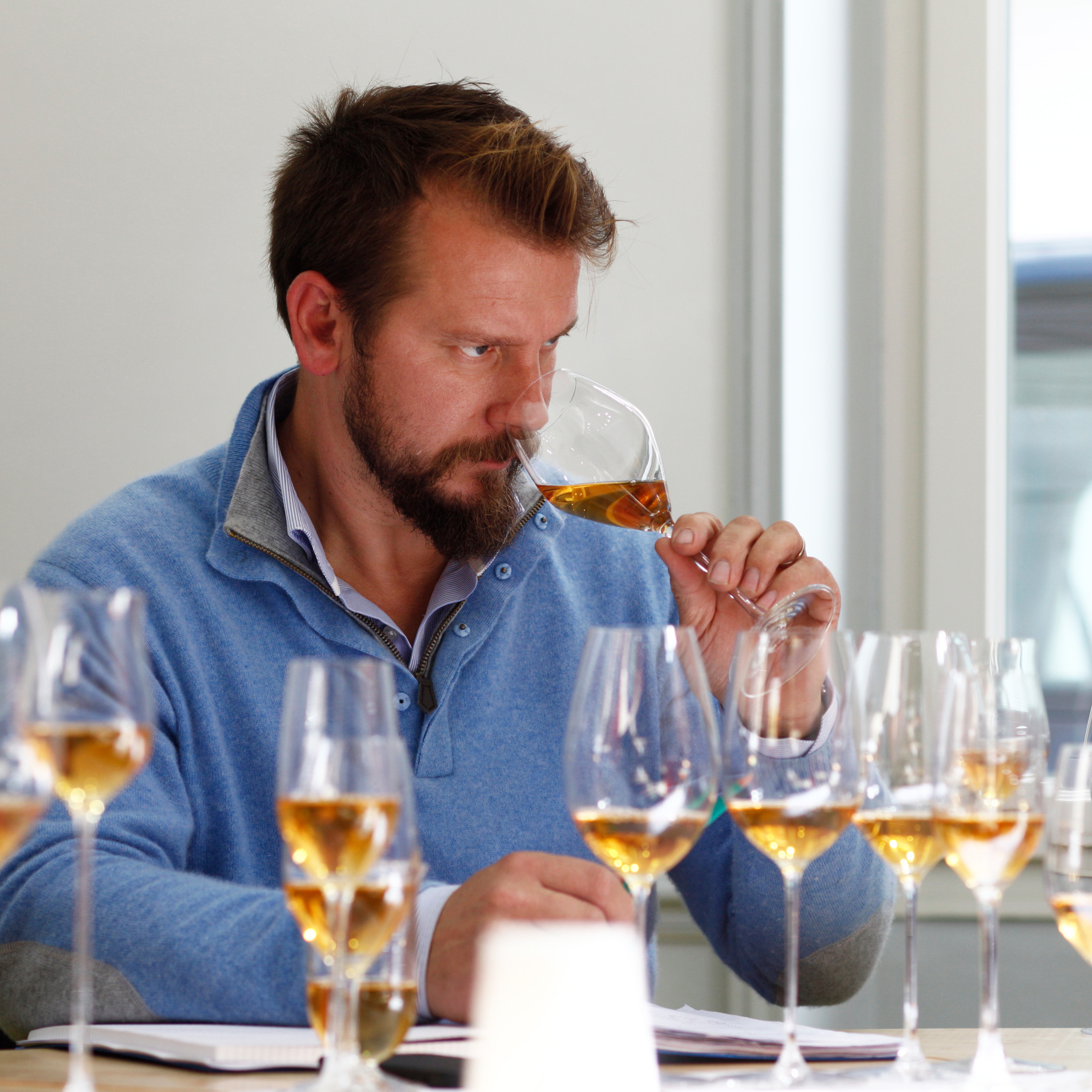
The third interview in Le Figaro Vin’s series takes us to Champagne to meet Sébastien Le Golvet, #48. A genuine hedonist, dedicated to enjoyment, he tells us how his winemaking trajectory and his passions are intertwined.
As befits a true bon viveur, Sébastien Le Golvet smokes a cigar throughout our interview. He inherited this passion from his father-in-law, Claude Giraud. He has been able to fit in seamlessly with his in-laws by embracing the spirit of innovation and independence so prized by the family. The outcome is champagnes that are unique, remarkable, vinous, and resolutely hedonistic.
Le Figaro: How does it feel to be crowned a winemaking champion?
Sébastien Le Golvet: I see myself as more of a leader than a champion, insofar as Maison Henri Giraud is above all a team. To use a French expression, I am the one pulling the cart rather than pushing it.
Have you been training for long?
We have been training to produce great wines for a long time, going back a number of generations. Our Réserve Perpétuelle, moreover, was launched by Claude Giraud in 1990 and we continue to develop this ground-breaking work, which is the signature of the estate, to this day.
Who is your mentor?
Claude, of course, who has had the patience to pass on to me his own passion for wine. It is also through him that I have learnt to make wine while smoking cigars. He has taught me the similarity between the great terroirs of tobacco and the great terroirs of wine. He has always been at my side. He is a visionary, which is so important for making champagne – you need lots of perspective.
Is wine a team sport?
Yes, you can go fast on your own but you go much further as a team. Speed is all very well but it frequently leads to excessive haste.
What is the key to making a good wine? The terroir or the winemaker?
In my view you cannot separate them. You cannot replicate the terroir, it is unique, and if the winemaker does not understand his terroir he will never make a great wine. For us what comes first – the terroir – forever depends on the well-being of, and respect for, nature.
To what do you owe your success?
I think I owe it, above all, to the history of the Giraud family, which has worked the vineyard at Aÿ since 1625. It’s a long history, and we owe our success to our terroir and to our family tradition of passing on know-how as well as assets.
Is your mother proud of you?
Yes, I think that she is very proud of how far my work has brought me in my devotion to wine. I think that the most satisfying achievement is to see your children flourish.
Who are your best supporters?
Our best supporters, first and foremost, are our customers, who come to our house, visit the Henri Giraud estate, stay at the manor, and enjoy an experience of well-being, through immersion in the terroir, and especially through “Craÿotherapie” (a concept of chalk baths and applications devised by Dr. Anne Le Golvet-Giraud, Sébastien’s wife, ed.). These are the people who then spread the good word about us far and wide, and they are our best ambassadors.
Your favourite colour?
My favourite colour – and I don’t know if it’s really a colour – would have to be gold, because for me it represents the lustre of Pinot Noir. Blanc de Noirs is thus the stroke of genius which has allowed us to make a great white wine with black grapes. That gives champagne its golden colour.
The king of grape varieties?
Pinot Noir, without question.
Your favourite wine?
I don’t really have a favourite wine because each wine has its moment, in every case an occasion for sharing and pleasure. For example, if I’m partying, I can drink litres, even bucketfuls of wine, but, conversely, the Arḡonne cuvée requires a different approach. Each wine has a distinct function.
Your favourite vintage?
2004. That’s the year my winemaking career began. I joined the domaine in 2002, and 2004 was the year of my first vinification alongside Claude. And, at the same time, it’s the year that the 15th generation arrived (with the birth of his eldest son, Arthur, ed.). Every time I open a 2004 it reminds me of both my life’s journey and an extraordinary vintage.
If your wine was a person, who would it be?
Our wines are all about joy, good humour, pleasure, fun and laughter, fine dining, and taste. If I had to compare them to a person, I would choose François-Xavier Demaison, an actor from the film Champagne. He paid us a visit and he is a truly exceptional person; brilliant, a true comedian!
What are the best circumstances in which to taste your wine?
Let’s deal with the basics first: a decent glass and the right temperature. These are the first two requirements, and then the magic does its work, because wine bonds us and binds us. It helps bring people together.
With whom?
To start with, you need to be curious about other people. When you have that curiosity and you are sharing a good wine, that’s when wine works its magic. People open up. You can talk about anything and everything, you take your time – it’s like smoking a cigar – and, if you are in the company of people who are curious about each other, you can pass an entire night conversing over a glass, or rather over a bottle.
Have you ever thought about chemically enhancing yourself, or your wine?
I tested negative at my latest drug test (laughs)! As for our wines, we are in the heart of an extraordinary vineyard here in Aÿ and I therefore think that today, rather than using chemicals, we ought to show nature the greatest respect, using minimal additives and interventions, by sticking to what is natural. We don’t need to do any more than that. It is rather a case of being in the right place at the right time, for the vines and wines alike.
For what price would you be prepared to sell your estate?
Selling our estate today is out of the question, so I cannot name a price. We are in the process of passing the estate to the next generation. Emmanuelle, my sister-in-law, who is taking over the reins at Domaine Henri Giraud, will write a new page marking the passage towards a new generation. Our wish is to perpetuate our know-how through the generations to come. And that is invaluable.
Who is your strongest competition in Champagne?
We don’t have any competitors because we feed off each other. Once again it’s about curiosity, visiting our peers, inviting them to our estate, getting to understand each other. We cannot be competitors, because we each have our own market. In our case we occupy a very specific niche. I don’t look at my peers as competitors but more as people that we can use as models, as sources of inspiration.
What has been your most innovative strategy in the vineyard and in the cellar?
In the vineyard we now use an absolute minimum of agricultural products. Furthermore, our Coteaux Champenois is called “triple zero”, with zero pesticide residues. For us this is something that really matters, something modern, and the fruit of our labour in the vineyard.
Turning to the cellar, our most innovative technical development there has been understanding how to marry two exceptional terroirs – the terroir of Aÿ Grand Cru with that of the forest of Argonne. I always say that it’s the story of the Beauty and the Beast. We have understood how to create this synergy between the two terroirs, which now produces an exceptionally great wine. For example, contrary to what you might expect, the Cuvée Arḡonne, vinified exclusively in new barrels, is not at all oaky, but expresses the terroir of Aÿ thanks to the forest of Argonne. With the Cuvée Arḡonne, the trema on the “g” alludes to the “y” of Aÿ, and thus to the fusion of the two terroirs.
Who would be your ideal successor on the podium?
Our ideal successor would be the 15th generation of the family. What excites Emmanuelle and me is the prospect of one of our children taking over. That is what we live for.
Le Figaro Vin
February 22, 2023
The worthy successor to his grandfather and father on an estate that produces some of the greatest Rieslings of Alsace: “Being a winemaker is not about measuring performance”.
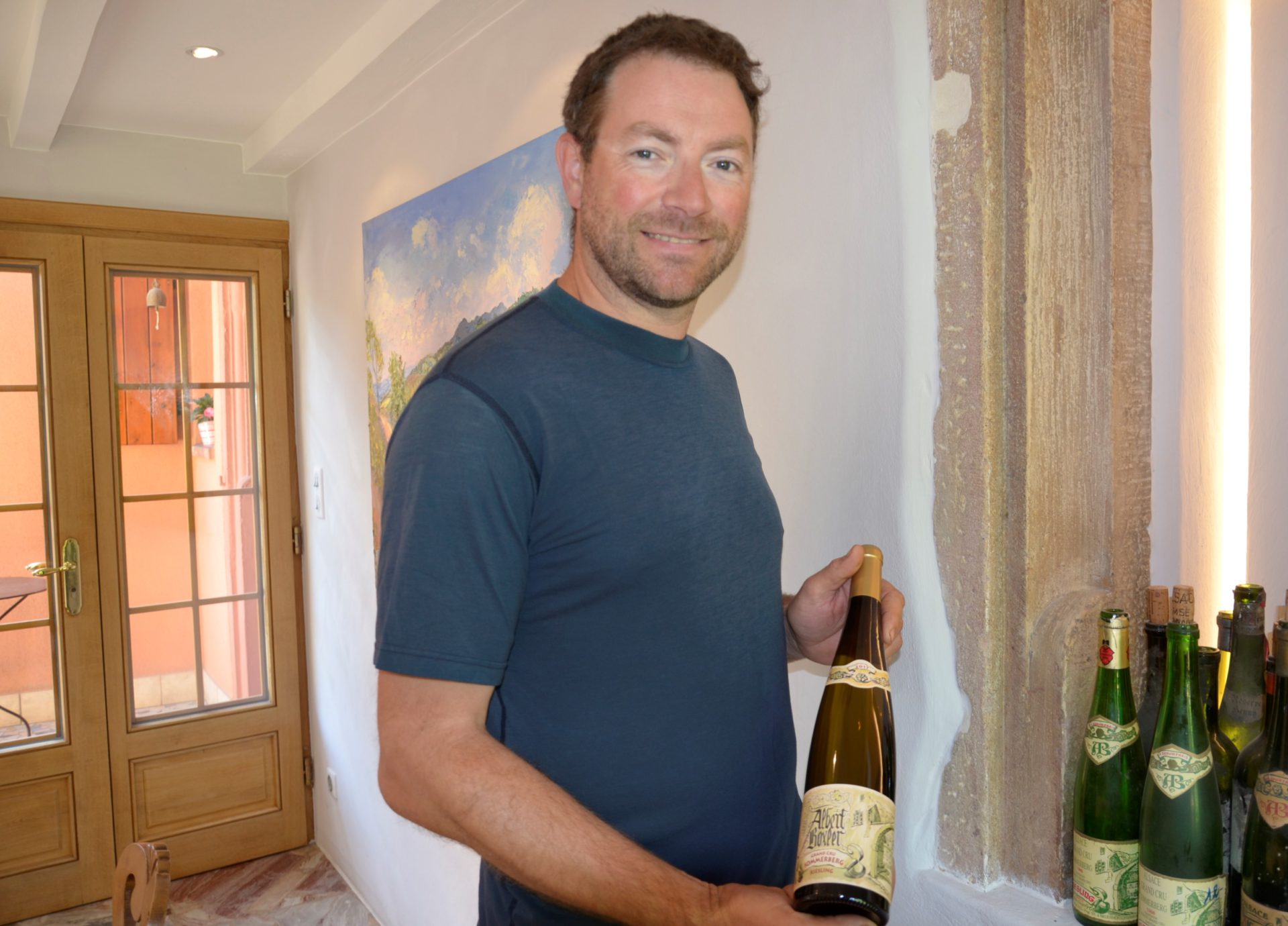
For the second in Le Figaro Vin‘s series of the 50 best winemakers in France we head off to Alsace, where we meet Jean Boxler, #49. He embodies the latest generation of an iconic Alsace estate, whose grands crus are equally seductive for lovers of natural wines and for the most sophisticated palates.
Domaine Albert Boxler is a family property, founded in 1672, on the hillsides of the Upper Rhine commune of Niedermorschwihr. Having worked side by side with his father for 25 years, Jean Boxler pursues his craft with the artistry of a goldsmith, producing wines of exceptional finesse on terroir known, nevertheless, for being extremely harsh. With great wisdom, despite his relative youth, he reveals his vision of a vocation which is based, for him, on passion, resilience, and sensitivity.
Le Figaro: How does it feel to be crowned a winemaking champion?
Jean Boxler: There are no champions. Being a winemaker is not about measuring performance but something far deeper and far less tangible. When you choose to do this job, you should not aspire to be the best. You must simply love your vines and try to do your work with as much sensitivity as possible.
Have you been training for long?
I started in 1996, so I have 26 vintages under my belt. At the same time, each year feels like my first. I attempt to refine things year by year, to avoid acting impulsively, and to focus on quality. Just as in sport, it is practice that allows you to manage the difficult times and cope with the random contingencies, and it’s precisely the charm of the unpredictable that makes life interesting.
Who is your mentor?
My father (who passed away in November 2022, ed.) and, until I reached 17, my grandfather. They taught me my passion for the job.
What is the key to making a good wine? The terroir or the winemaker?
You need a winemaker to make good wine. But it takes both to make a great one.
To what do you owe your success?
I am not sure whether success can be measured by any specific criterion, as I don’t like to be pigeonholed in a particular style. I think that wine involves something more conceptual. First and foremost, wine is a social bond. In current winemaking talk I notice a kind of radicalisation in the approach to production methods, sometimes to the detriment of the wine. Sadly, that creates a disconnection from the true purpose of production. There is no rule book for making good wine, rather there are different ways of getting there. The secret of success is therefore more to do with passion, conviction, and self-denial, which invariably end up paying off.
My parents and grandparents had a certain style, taste, and a concern for balance and simplicity, combined with a desire to produce grapes of exceptional quality, without ever resorting to cutting corners or to technical excess. Our success is measured by the loyalty of our customers, some of whom have enjoyed our wines for over 30 years. That has given us our greatest satisfaction; we make wines that we like to drink.
Is your family proud of you?
It’s not a subject that we ever touch on. My father and I shared our passion for wine, day by day, for 25 years. He was my best guide. We never spoke about pride but about wine and nature.
Who are your best supporters?
I would say our American importer from the 1980s, Robert Chadderdon. It was a serendipitous meeting, with an outstanding taster, and we were on the same wavelength. He had a great deal of respect for our work.
Red or white wine?
I have a soft spot for Rieslings, so it’s whites. But balance, emotion, and vibrancy are what I look for most of all.
The king of grape varieties?
Riesling. It is complex, has a lot of character, and is completely uncompromising. It perfectly reflects how you nurture it. It is incapable of hiding its feelings. This is no doubt down to our transparent terroir, with its crystalline granite soils on which Riesling is an open book. Riesling combines great purity with great candour.
Your favourite wine?
The Riesling Sommerberg Grand Cru “E” (lieu-dit Eckberg).
Your favourite vintage?
2017, which was a complete vintage across the spectrum. Otherwise, no doubt, 2023!
If your wine was a person, who would it be?
A wine is made in its maker’s image
What are the best circumstances in which to taste your wine?
When you are relaxed.
Have you ever thought about chemically enhancing yourself, or your wine?
No, because winemaking is not a competition. Everything depends on being able to mitigate any defects by making the right decisions, especially during the harvest. By keeping tuned into your plots, your work is already done. Doping and comparable interventions are an admission of failure. Their consequence is that your wine can never achieve greatness.
For what price would you be prepared to sell your estate?
I have three boys, two of them interested in winemaking, so the question does not arise.
Who is your strongest competition in Alsace?
Probably Gérard Schueller, even if his son Bruno has gone down a different route. The father’s wines were monumental.
Which competitions do you dread the most?
The harvest. It is, at once, the most beautiful of times and the most anxiety-inducing, because you have to manage the human, the climate, and the condition of the vines. I would say that the greatest challenge today, because of the climate, is the fear of destabilisation.
What was your greatest win?
Passing on my love of winemaking to the next generation.
What has been your most innovative strategy?
Understanding how to work with people. Wine is a team sport.
Who would be your ideal successor on the podium?
My sons.
The technical director revolutionising Pomerol’s Château L’Évangile: “If my wine was a person, it would be Catherine Deneuve”.
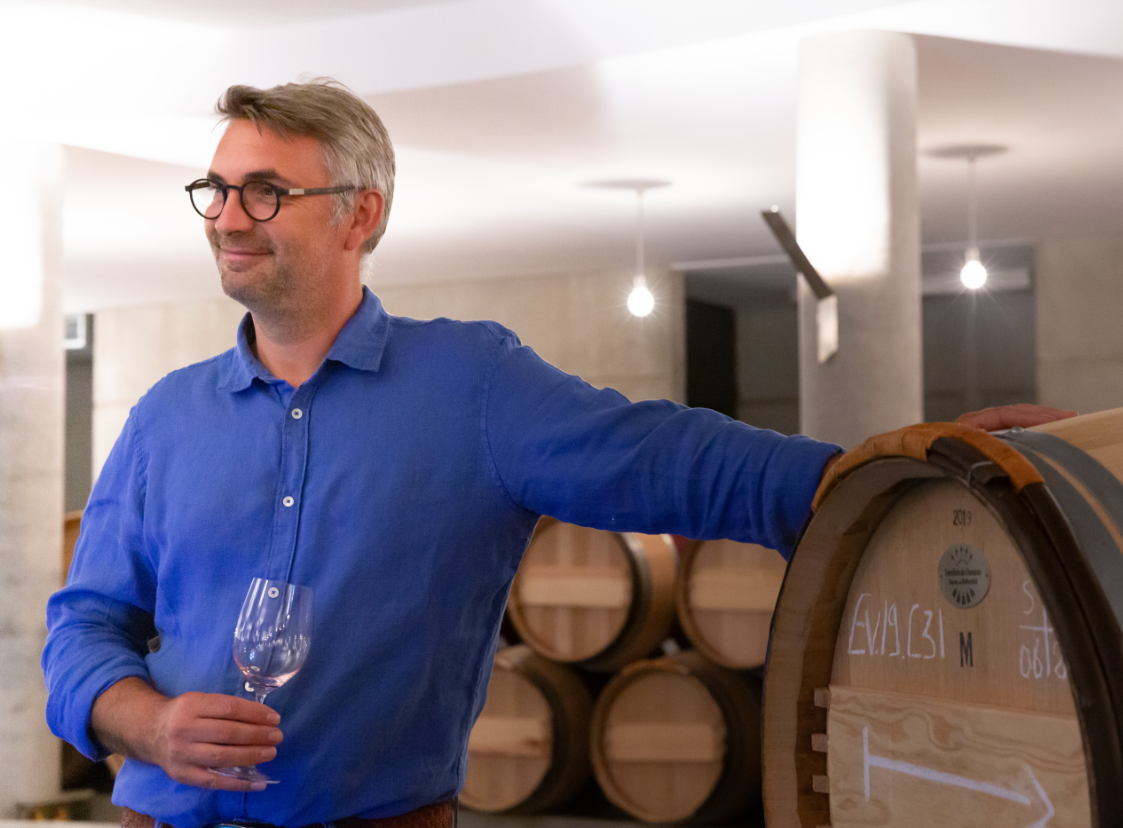
Wine Lister’s parent company, Le Figaro Vin, has launched its inaugural series of the 50 best winemakers in France in 2023. Interviews with each winemaker making the top 50 will be published throughout the course of the year – in French on the Le Figaro Vin website, and in English on Wine Lister’s blog. The first in the series, #50, is Olivier Trégoat – Technical Director of Pomerol’s Château L’Évangile. Here he shares the highlights of his viticultural journey so far. In just a few years, Olivier Trégoat has managed to realise the full potential of l’Évangile, getting the most out of the appellation’s natural generosity, while reinstating a remarkable freshness in the wine.
Le Figaro: How does it feel to be crowned a winemaking champion?
Olivier Trégoat: I am very happy, but give most of the credit to the team, as it is, above all, a real collective effort. Alone, I would be good for nothing.
Have you been training for long?
Yes, I’ve been training since 1997. Everything I’ve done in my previous winemaking roles contributes to what I have achieved at L’Évangile. I got my start in Saint-Émilion, which catalysed my interest in soil studies – while my previous job as an independent consultant for large Bordeaux estates (including Château Cheval Blanc) was invaluable.
Who is your mentor?
At the start of my winemaking journey, it was Kiss Van Leeuwen, a viticulture professor at Bordeaux Sciences Agro and the Institute of Vine and Wine Sciences (ISVV). Today, my mentors are my neighbours in Pomerol – whose proximity prevents me from making mistakes and provides me with constant inspiration.
What is the key to making a good wine? The terroir or the winemaker?
The terroir. For me, climate and soil make up 80% of the wine.
To what do you owe your success?
To my education, my curiosity, and the tools at my disposal – a triptych of soil, vine, and wine.
Is your family proud of you?
Yes, I’m sure they are.
Who are your best supporters?
Paradoxically, some of my competitors, but also my former clients from when I was an independent consultant.
Red or white wine?
The older I get, the more white wine I drink!
The king of grape varieties?
Cabernet Franc. At Château L’Évangile, it’s a grape variety that we will continue to plant and conduct research into – particularly because of its freshness. And also because I love the wines of the Loire Valley!
Your favourite wine?
Château L’Évangile 2006. It is a harmonious vintage that offers the delicate touch of l’Évangile’s hallmark tannins, alongside a more fleshy characteristic – but without excess, and still retaining a beautiful freshness.
Your favourite vintage?
2011 – something slightly different. It was not well understood around the time of its release, and it came after 2009 and 2010, which were widely-recognised as exceptional vintages. It’s just starting to open up today.
If your wine was a person, who would it be?
Catherine Deneuve. A great, timeless actress who knew how to challenge herself in different roles.
What are the best circumstances in which to taste your wine?
Drink it with people you love.
Have you ever thought about chemically-enhancing yourself, or your wine?
No, never. Nature is generous in Pomerol; I always say that I have my foot on the brake rather than the gas.
Who is your strongest competition in Pomerol?
Château Lafleur.
Which competitions do you dread the most?
Frosty periods in early April.
What was your greatest win?
I had beginners’ luck. My entire career in wine so far has been a bit like a race in which I have ended up on the podium against all odds!
What has been your most innovative strategy?
While we do things in a very simple manner in the winery, in the vineyard, we make very rigorous intra-parcel selections on different soils. I sometimes say that we harvest in a Sauternes style. We love to split hairs during this critically decisive period. It’s a real challenge to be a winemaker in Pomerol today.
Who would be your ideal successor on the podium?
On the podium, Château Lafleur. They are very sharp and precise in what they do, with consistently good ideas. And for my successor at the estate, I don’t know yet…
A few words about the estate:
The property was founded in the mid-18th century under the name “Fazilleau”. At the beginning of the 19th century, the Léglise family, who played a significant role in expanding the vineyard, sold it to a lawyer named Isambert, who renamed it L’Évangile. He expanded the estate to around 13ha – not far off its current size.
Since 1990, Château L’Évangile has been under the helm of Baron Éric de Rothschild, who also owns Château Lafite in Pauillac (among others in the appellation), as well as Château Rieussec in Sauternes. His daughter, Saskia, a former New York Times correspondent writing from the Ivory Coast, and the author of a novel, joined her father in Bordeaux in 2017. The estate has benefitted from significant investments, as well as the technical expertise of the Domaines Barons de Rothschild (Lafite) teams for over 30 years. Juliette Couderc was appointed Chief Operating Officer in 2020, having previously managed the vineyards of Chinese estate, Long Dai, which also belongs to the group. She works alongside Olivier Trégoat.
As the year draws to a close, Wine Lister has published its 2022 Wine Leagues – the third of our annual reports celebrating the top-performing wines and producers within several categories over the past year. The Leagues reveal exciting developments in the world of fine wine, shining a light on consumer trends and estates on the rise, informed by an in-depth trade survey with key industry figures.
Please see some of our key findings below, or click here to download the full study.
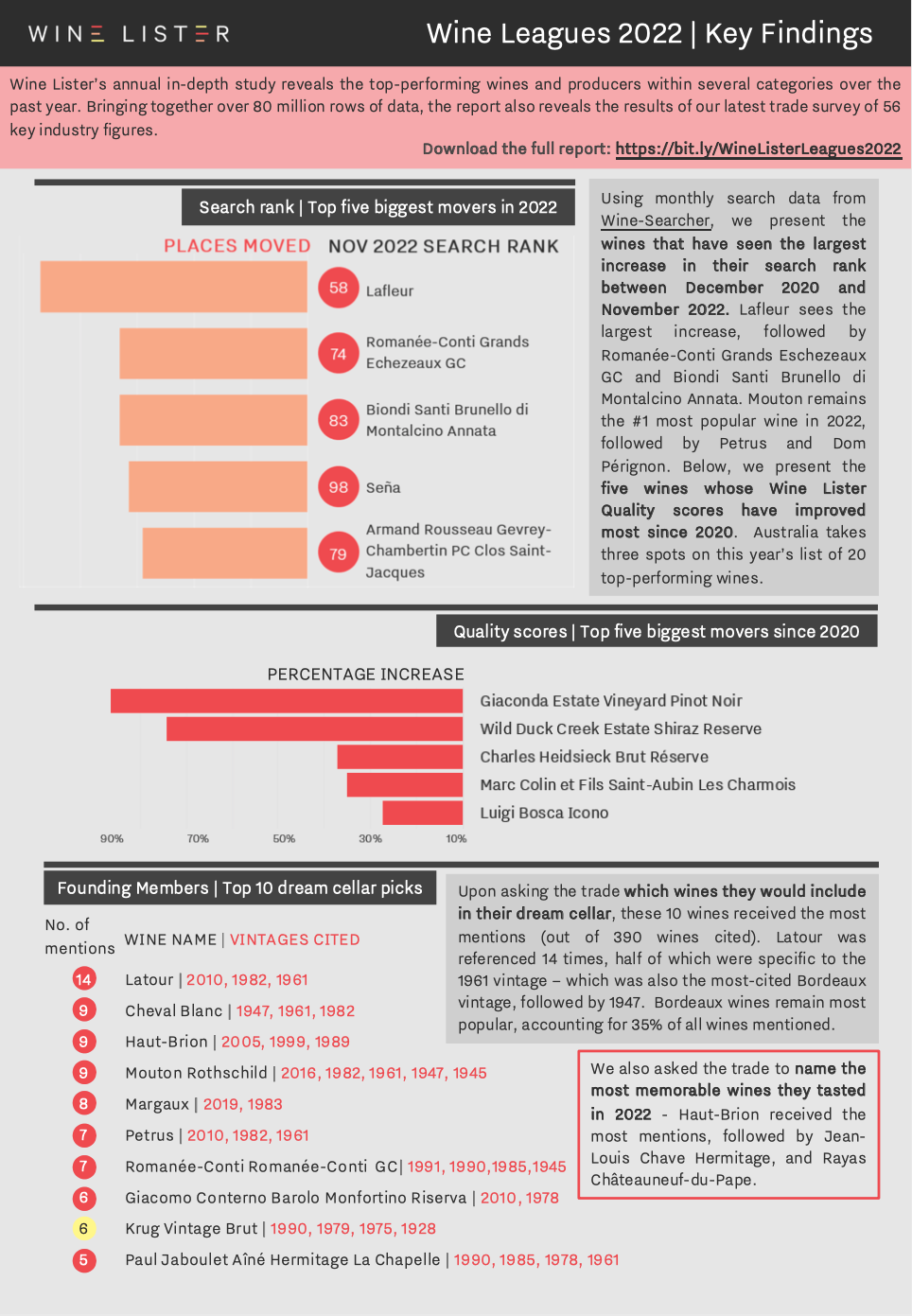
With a bank of knowledge on some of the world’s most delectable wines, sommeliers have the ultimate insider insight into which bottles are worth picking up. With this in mind, Wine Lister asked some of the world’s top sommeliers to share with us their favourite wines retailing for under £35 per bottle.
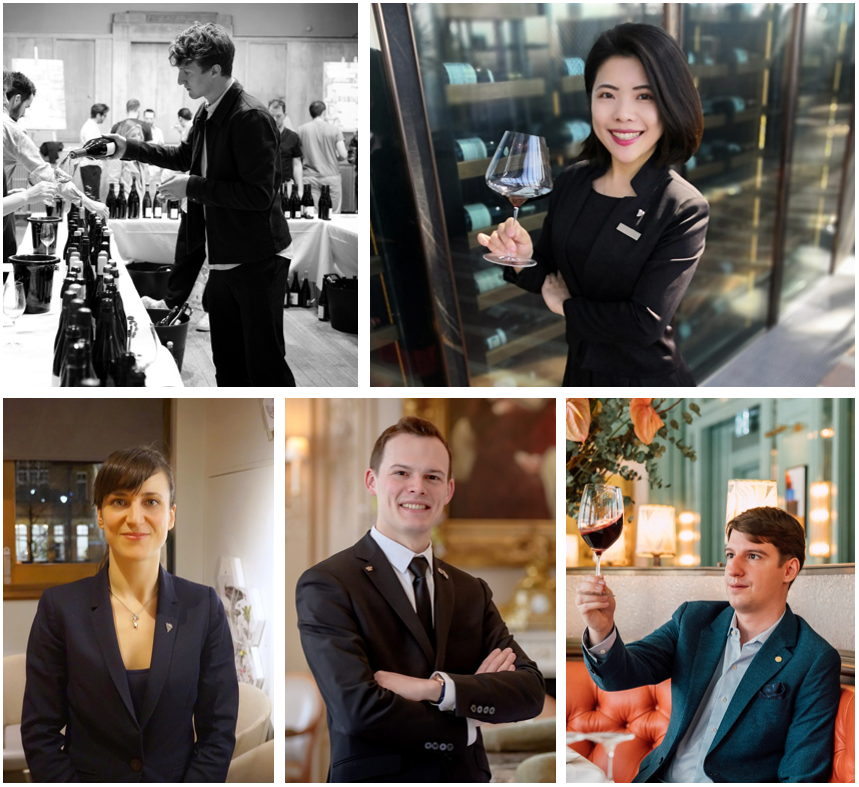
Clockwise from top left: Joshua Castle (Noble Rot), Lesley Liu (Odette), Marc Almert (Baur au Lac), Martin Jean (Domaine les Crayères), Sara Rossi (Trinity)
Joshua Castle (Noble Rot, London)
Joshua contends that “without a shadow of a doubt, Greece is producing some of the best value-for-money wines”, noting that “the most successful producers are tapping into the country’s long viticultural history, wealth of old vines, and indigenous varieties”. He cites white wines produced from grapes such as Robolla, Roditis, and Savatiano “have been a huge success in the UK on-trade” while his pick his for “a great-value Greek wine is the red Agiorgitiko ‘Natur’ from Tetramythos, a producer based in the Peloponnese”. “Acidity, fresh flavours, and light extraction are on the agenda”, according to Joshua, who admires winemaker Panagiotis Papagiannopoulos’ tempering of Agiorgitiko’s often tannic profile – resulting in a bright crunchy expression. “I first drank it at the fantastic central Athens wine bar ‘Heteroclito’ where its energetic fruit, moderate alcohol, and glou-glou style has me hooked.”
Agiorgitiko ‘Natur’ 2021 can be found in Noble Rot’s London wine shop, Shrine to the Vine, for £17 per bottle
Lesley Liu (Odette Restaurant, Singapore)
Lesley recommends a Torrontés, citing how well it compliments the tropical climate of Singapore with its refreshing minerality and “lingering floral and sweet notes of delicate exotic fruit, fleshy citrus, and wild honey”.
Lesley is particularly impressed by the barrel-fermented Torrontés produced by Susana Balbo – the first woman in Argentina to graduate with a degree in oenology. Lesley describes it as “a new chapter for Torrontés”, due to the complexity imparted by the French oak barrels – “an unusual choice for aromatic varieties”. She commends the versatility of the grape, which lends it to being a great match for all manner of Asian dishes as its “acidity can cut through the oil present”.
Susana Balbo Signature Barrel Fermented Torrontés 2019 can be found in Roberts and Speight from £18 per bottle.
Marc Almert (Baur au Lac, Zürich)
Marc points to the wines of Côtes du Rhône for “some of the true best-buys in French wine”, and advocates looking beyond the big-name appellations such as Châteauneuf-du-Pape and Côte Rôtie, and instead towards smaller regional appellations which “often offer great ‘bang for your buck’, whilst displaying a sense of terroir”.
Marc recommends the Mistral Domaine de Ferrand. “The Bravay family named this highly-quaffable entry into their portfolio after the namesake northwesterly wind which is key to Rhône Valley viticulture.” He praises its palate, which boasts “a rich array of violet, spice, and of course dark red fruits” and says that “it possesses a great acidity back-bone, soft tannins despite its youth, and is the kind of red wine I like to enjoy after a long service.”
Mistral Domaine de Ferrand 2020 is available from Hedonism Wines for around £19 per bottle.
Martin Jean (Domaine les Crayères, Reims)
Martin shares a recent favourite from a blind tasting with friends – “a sommelier friend had brought the Jaspe 2016 cuvée from Dominique Hauvette. It was a real favourite during the tasting, and something that I would want to share around a barbecue, with some grilled spiny lobster, decorated with some Provençal tomatoes, and an eggplant pie – simple dishes to share with family and friends.”
Martin praises this biodynamic, Roussanne-dominated cuvée for “its balance, its vibrancy, and saline notes”.
Domaine Hauvette ‘Jaspe’ 2016 is currently difficult to find in the UK, but can be found in outlets abroad such as Terroirs in Dublin from around £34 per bottle (excl. shipping).
Sara Rossi (Trinity Restaurant, London)
Sara has always been “fascinated by Slovenian wines because of their unique style and personality”. She particularly recommends Cotar Terra Rossa, a blend of Teran, Merlot, and Cabernet Sauvignon, describing its “delicate aromas of violet, sour red cherries, rosemary, and sage”. Sara praises its “refreshing acidity and firm tannins”, as well as its “long and complex finish”. Her ideal pairing for Terra Rossa would be “homemade truffle linguini pasta or roast grouse”.
Though currently unavailable in the UK, Cotar Terra Rossa 2009 can be found in European retailers such as Germany’s Vinoteca Maxima from £22 per bottle (excl. shipping).
The Place de Bordeaux’s 2022 September campaign has seen its third week of releases, with a number of key entries including the likes of Pym Rae 2018, Dalla Valle Maya 2019, and Château Palmer 2012.
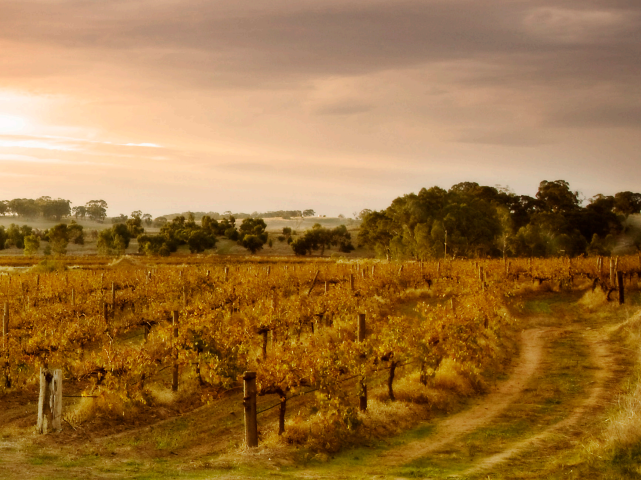
The Armagh vineyard in autumn
Following a UK bank holiday on Monday to mark the funeral of Queen Elizabeth II, Tuesday 20th September morning saw several releases in quick succession, starting with Pym Rae 2018, which entered the market at a recommended retail price of £270 per bottle. Tasting at the CVBG Beyond Bordeaux London event earlier this month, Wine Lister’s Founder and CEO, Ella Lister found this vintage to be a real step-up from the Tesserons’ Californian outpost, awarding the 2018 96 points and noting “exceptional balance, the texture of taffeta, and an addictive softness”.
Another standout release, Telmo Rodríguez’s Yjar saw its second ever vintage – 2018 – released through the Place at £95 per bottle (in-bond). Tom Parker (tasting for jancisrobinson.com) awards a score of 17, while Ella scored 96 points, comparing its balance to that of “a ballet dancer, toned and delicate”, noting that it is “the perfect wine for today’s palate”. The 2018 vintage saw a production volume of just 6,000 bottles – a reduction of 1,000 bottles compared with the 2017.
The Armagh Shiraz 2018 was also released on Tuesday at £165 per bottle (in-bond), with Ella awarding 95 points and describing the latest offering from Jim Barry as “rich and opulent” – a vintage “worthy of the 50 years since the first Shiraz was planted at the domaine in 1968”.
Wednesday 21st September saw the release of Le Petit Cheval Blanc 2020, which entered the market at £100 per bottle (in-bond). It was shortly followed by Giovanni Rosso Barolo Ceretta 2018, released at £51 per bottle (in-bond). Walter Speller (for jancisrobinson.com) awards the latter a score of 17++, describing it as “simply gorgeous” and praising its “beautifully sculpted chewy tannins”.
Next up on Wednesday, Dalla Valle Maya 2019 was released at £464 per bottle (in-bond), marking the first vintage produced since the estate committed fully to biodynamic practices. Another first – Château Haut-Batailley introduced its 2016 vintage to the market at £36.67 per bottle (in-bond). A transitional year, the Cazes family acquired the estate shortly before the 2016 primeurs and oversaw blending, while vinification had been carried out by the previous owners (the Borie family) – provoking the decision to withhold its release. The 2016 bottle features a transitional label – neither the previous label under the Borie family, nor the new label under the Cazes family, debuted in 2017. Neal Martin (for Vinous) awards the 2016 94 points, calling it “an outstanding Haut-Batailley”.
Château Palmer released ex-château stock of its 2012 vintage on Thursday 22nd September, the third vintage to be released from the estate’s “Ten years on” series. Since 2010, approximately half of each year’s production has been reserved in the cellars, while the remaining half is sold en primeur. The 2012 vintage was released at £257 per bottle (in-bond), having achieved scores of 17 from Jancis Robinson (for jancisrobinson.com) and 94 from Antonio Galloni (for Vinous).
Also released this week were Cobos 2019 and Clos des Goisses 2013.
Likely to be released next week are Kracher Tba N°5 Grande Cuvee 2019c, Château d’Avize 2012, Morlet Cœur de Vallée 2019, Allegrini Fieramonte 2015, La Poja 2017, and Biserno 2017.
With this year’s September campaign now in full swing, we examine some of the key releases from the second week, including offerings from Château Latour, Bibi Graetz, and Catena Zapata.
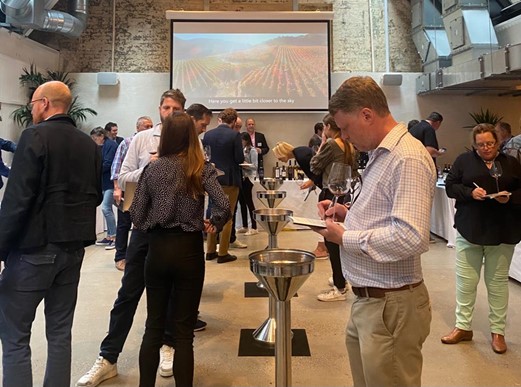
The Wine Lister team got the chance to taste a number of wines scheduled for release during this year’s CVBG ‘Beyond Bordeaux’ tasting in London on 8th September 2022
One of the most anticipated releases from this year’s campaign, ex-château stock of Château Latour’s iconic 2010 vintage was released on Tuesday 13th September. Release prices varied, with listings for the latest tranche started from around £1,045 per bottle (in-bond). Tasting twice from magnum in February 2020, Vinous’ Neal Martin awards it a perfect score of 100 points, declaring that the wine “can be summed up in two words: ‘The king’”, while the 2020 earns the wine’s joint-highest WL score (98) alongside the 2005.
Tuesday also saw two releases from Bibi Graetz; Colore 2020, offered by some retailers at £173, was a Wine Lister favourite at the CVBG tasting. Wine Lister’s CEO Ella Lister described it as a “calming, zen wine, with all the confidence, wisdom, and stillness befitting a wine from such ancient vines”, referring to its “neverending finish” and scoring it 98 points. Testamatta 2020 was also released, garnering a score of 95 points from Ella and fetching a price of £68 from retailers.
Released the same day, Joseph Phelps Insignia 2019, has so far seen merchant offers of around £182.50 per bottle (in-bond). Ella scored the wine 97 points and found that it has “the usual power of Insignia, but with a newfound subtlety and sophistication and fine tannins”. This could be down to the record-high proportion (25%) of fruit from Rutherford in 2019 – while the vintage also marks the first to include fruit from the new Joseph Phelps vineyard, El Venadito, located in the Oak Knoll District.
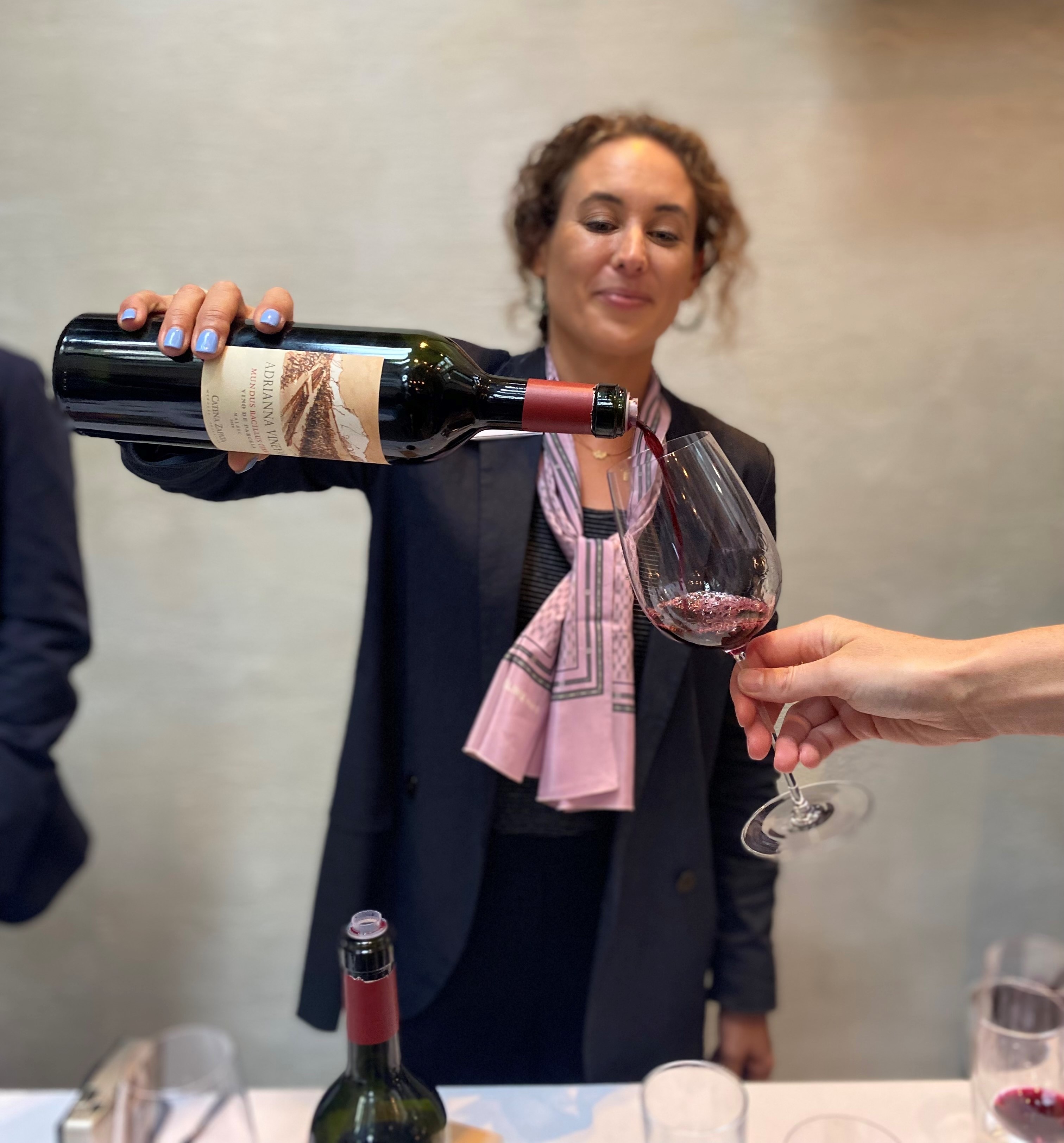
Adrianna Catena pouring her namesake wine for the Wine Lister team at the CVBG ‘Beyond Bordeaux’ tasting in London
Thursday morning saw two entries from the Catena Zapata stable – the 2019 vintages of Nicolás Catena Zapata and the Adrianna Vineyard Mundus Bacillus Terra. Nicolás Catena Zapata entered the market with a recommended UK retail price of £61 per bottle, having achieved a score of 96 points from Joaquin Hidalgo (Vinous). Adrianna Vineyard was released with a UK recommended retail price of £161 per bottle. Tasting in London, Ella awarded it 98 points, praising its “hedonistic bouquet”.
The morning of Friday 16th September marked a new entry to the Place this year – Belles Sœurs Cuvée Pinot Noir 2019 entered the market at £82 per bottle (in-bond). While Beaux Frères and Belles Soeurs 2019 were initially intended to be released together during last year’s campaign, reduced yields as a result of fires instigated the decision to release Beaux Frères 2019 last year and Belles Soeurs 2019 this year. Both cuvées will be released in tandem next year.
The 2013 vintage of Lindaflor La Violeta was also released on Friday 16th September, at £72.50 per bottle (in-bond) – having already been released in the form of a special-edition case alongside the 2011 vintage of its Bordeaux brother, La Violette, in March this year (at £325). Friday’s release marks the first solo introduction of the Parent family’s Mendoza estate through La Place, giving buyers the chance to acquire it in its own right. Tasting in Bordeaux, Ella awarded 93 points and found a nose that is “deep, meaty, with notes of paprika… sparkling, singing, seductive” and a palate of “exquisite freshness […] with a fine but firm structure”.
Also released this week were Penfolds Bin 169 2019, Petrolo Galatrona 2020, Cheval des Andes 2019, Joseph Phelps Cabernet Sauvignon 2019, Siepi 2020, Orma 2020, Caiarossa 2019, and Beaulieu Vineyard Georges de Latour 2019.
Next week’s releases are likely to include Petit Cheval Blanc 2020, Haut Batailley 2016, Cobos 2019, Giovanni Rosso Barolo Cerretta 2018, Pym Rae 2018, Clos des Goisses, and Palmer 2012.
The Place de Bordeaux has welcomed dozens of new wines through its distribution system this year, with new releases expected from Champagnes Barons de Rothschild, Biserno, and Parusso, alongside old favourites such as Caiarossa, Catena Zapata, and Penfolds, among others. As the campaign kicks off, we take a closer look at the first week of entries.
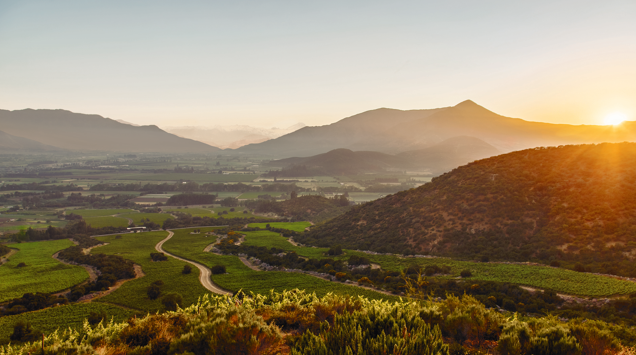
Dawn at Seña vineyard. The Wine Lister team tasted Seña 2020 with the Viñedo Chadwick and Seña team via Zoom last month
Inaugurating this year’s campaign on Thursday 1st September was an offering from Seña, whose 2020 vintage was released at £85.83 per bottle (in-bond). Tasting with Wine Lister on Zoom, the Seña-Chadwick team explained that although 2020 was an unusually warm year in Chile, a wide diurnal range in the vineyards (thanks to its 230 – 460m altitude) made for a long ripening season, allowing the grapes to develop intensity of flavour whilst retaining freshness. The Wine Lister team describes the latest release as opulent, with a complex nose of black fruit, plum and spice; on the palate, its berry intensity is complemented by notes of cigar box and grilled meat.
Quintessa 2019 followed swiftly, and has so far been offered in the UK for £180 per bottle (in-bond). Antonio Galloni (Vinous) awards Quintessa 2019 94 points, calling it “one of the best wines I have tasted here in some time”. Another offering from Rutherford in the Napa Valley, Inglenook Rubicon 2019 was released on Friday 2nd September at £143 per bottle (in-bond).
Released on Monday 5th September, Opus One 2019 entered the market at £252 per bottle (in-bond), with the latest vintage so far receiving acclaim from critics including Antonio Galloni (Vinous), who awards 97 points and writes that “it has all the classicism that is such an Opus One signature” and praises its “sublime finish”. Opus One is one of the top 15 best fine wine brands in the world, according to Wine Lister’s Brand score (as part of our Pro scoring system, see more here) – with high quality in 2020 further cementing this reputation.
Tuesday 6th September saw the latest release from Masseto, whose 2019 vintage (released at £440 per bottle in-bond) was the first to be made entirely in the estate’s new dedicated state-of-the-art winery, as well as the first with 10% Cabernet Franc added to an historically 100% Merlot composition. These changes appear to have yielded positive results, with Vinous’ Antonio Galloni describing Masseto 2020 as “fabulous”, adding that it is “Silky, gracious, and super-refined”.
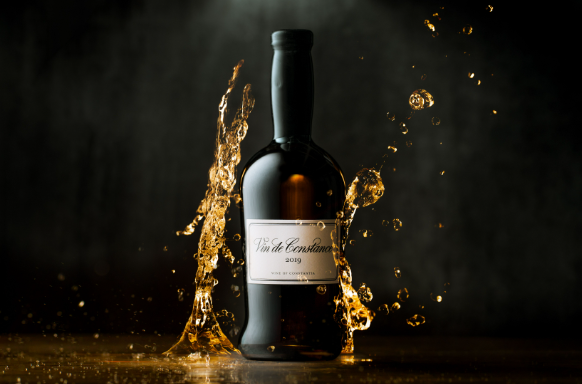
Vin de Constance 2019 was released on Tuesday 6th September
Following suit on Tuesday 6th September, Vin de Constance 2019 entered the market at £45 per 500ml bottle (in-bond). Achieving its highest Wine Lister score since the 2012 vintage (96), the 2019 is awarded 97 points from Vinous’ Neal Martin, who calls it a “superb Vin de Constance […] a step closer to what you might confusingly call a non-sweet dessert wine” – high praise indeed.
Wednesday 7th September saw the release of the 25th vintage of Almaviva – a warm and dry year, the 2020 harvest arrived almost three weeks earlier than usual. Almaviva 2020 entered the market at £120 per bottle (in-bond).
On Thursday 8th September, Château d’Yquem released the last remaining half bottles of the 2016 vintage ex-château at £165 per bottle (in-bond). The vintage achieved a Wine Lister score of 96, with Neal Martin (Vinous) tasting in February this year, awarding 95 points and noting it “has gained a bit more complexity in recent years”. Solaia 2019 was released on the same morning, with a likely UK onward selling price of £218 per bottle. Antonio Galloni (Vinous) sings its praises, giving 97 points and describing it as “the sort of wine I would like to spend a whole evening with”.
Viñedo Chadwick 2020 was also released on Thursday morning, so far being offered in the UK at around £232 per bottle (in-bond). This particular vintage is made from 100% Cabernet Sauvignon (Petit-Verdot is usually included in the blend). Tasting with the Seña-Chadwick team on Zoom, Wine Lister describes it as a complex and opulent offering, exhibiting great energy, freshness, and intensity.
Friday 9th September saw the release of L’Aventure Estate Cuvée 2020 at a recommended UK onward selling price of £83 per bottle (in-bond). Wine Lister CEO Ella Lister (tasting on behalf of Le Figaro Vin) awards the 2020 95 points, describing it as “Pure and upfront on the nose, with dark fruit, slate, and cinnamon”. It should be noted that the next release of l’Aventure Estate Cuvée will be in September 2024, as the property is skipping a year in order to age the 2021 longer.
Also released this week were Cloudburst Chardonnay 2020, Cloudburst Cabernet Sauvignon 2019, Beaucastel Hommage à Jacques Perrin 2020, Opus One Overture 2019, Massetino 2020, Rieussec 2020, and R de Rieussec 2021. Upcoming releases over the next week are likely to include Penfolds Bin 169 2019, Cheval des Andes 2019, Bibi Graetz Colore 2020 & Testamatta 2020, Latour 2010, Petrolo Galatrona 2020, Catena Zapata Nicolas 2019, and Beaulieu Vineyard Georges de Latour 2019.
Despite the challenges brought throughout the growing season of the 2021 vintage, Bordeaux’s dry whites shone in terms of quality. To guide those still considering their 2021 Bordeaux en primeur purchases, Wine Lister presents some of the best choices in Bordeaux whites from the vintage, at five different price points. (All prices are quoted in-bond per bottle when purchasing by the case).
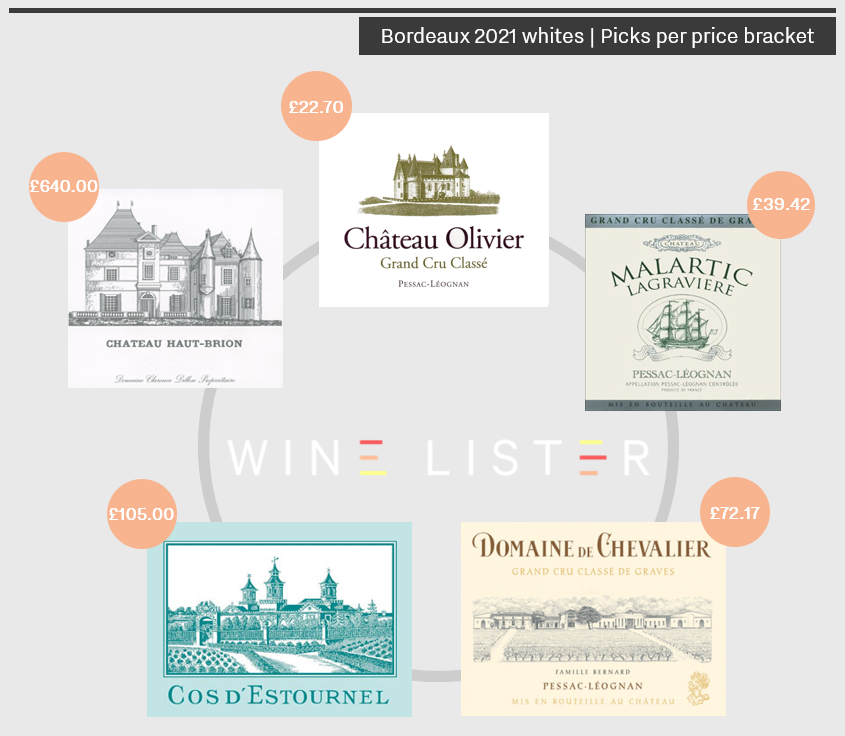
Under £25 – Olivier Blanc
The 2021 vintage from Château Oliver’s white was described by Jancis Robinson as “Racy and lively” with a “good balance of interesting fruit and zest”. Ella Lister (for Le Figaro) gave Olivier 2021 a score of 92-93, praising its balance and describing it as an “ethereal and harmonious blend of Sauvignon and Sémillon”. Olivier 2021 can be purchased from Millésima for £22.70.
Under £40 – Malartic-Lagravière Blanc
Awarding 90-92 points, Antonio Galloni (Vinous) describes the latest vintage of Malartic-Lagravière as “Bright and sculpted”, with “plenty to offer”. Jancis Robinson deems it “Already attractive” and “Impressively persistent”. Malartic-Lagravière Blanc appears on Wine Lister’s list of value picks in Part II of our 2022 Bordeaux Study, indicating a strong quality-to-price ratio. Elsewhere in the study, Wine Lister found that Malartic-Lagravière is enjoying a robust short-term (six-month) price performance of just under 14% – placing it in the top 15 short-term price performances. Malartic-Lagravière 2021 can be bought from Justerini & Brooks for £39.42.
Under £75 – Domaine de Chevalier Blanc
The 2021 vintage from Domaine de Chevalier has received acclaim from the critics, with Neal Martin (Vinous) awarding its white 95-97 points and declaring it “one of the best Domaine de Chevalier whites that [he has] tasted in 20-plus years”. Jancis Robinson confers a score of 17+ and writes that it “should be a real long-distance runner”. Domaine de Chevalier Blanc 2021 can be bought from Farr Vintners for £72.17.
Under £110 – Cos d’Estournel Blanc
The only wine among the five selected here not to hail from Pessac-Léognan, Cos d’Estournel’s Blanc 2021 receives its joint-highest Wine Lister score in over 15 years. Indeed, Antonio awards it 93-95 points, above last year’s vintage (91-93), and writes that it is “one of the finest vintages I can remember tasting”. He praises its “sheer palate presence”, a sentiment Ella echoes as she describes Cos d’Estournel Blanc 2021 as “delectable, lingering in the mouth”. Cos d’Estournel Blanc 2021 can be purchased from Berry Bros. & Rudd for £105.
Under £650 – Haut-Brion Blanc
One of the most noteworthy releases of the 2021 Bordeaux en primeur campaign is the latest white from Haut-Brion. In such a challenging vintage, Haut-Brion Blanc 2021 seriously impresses as it sees the greatest increase in Quality from 2020 to 2021 – as explored in Part II of Wine Lister’s 2022 Bordeaux Study. The 2021 vintage also achieves the wine’s highest ever potential en primeur score from Vinous as Neal awards it 96-98 points. Haut-Brion Blanc 2021 can be purchased from Cru World Wine for £640.











